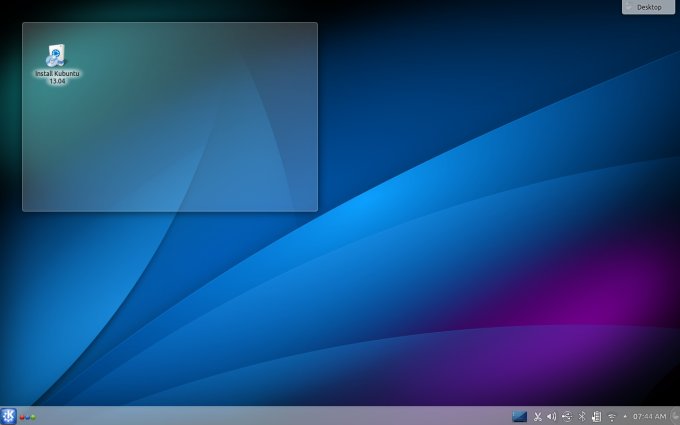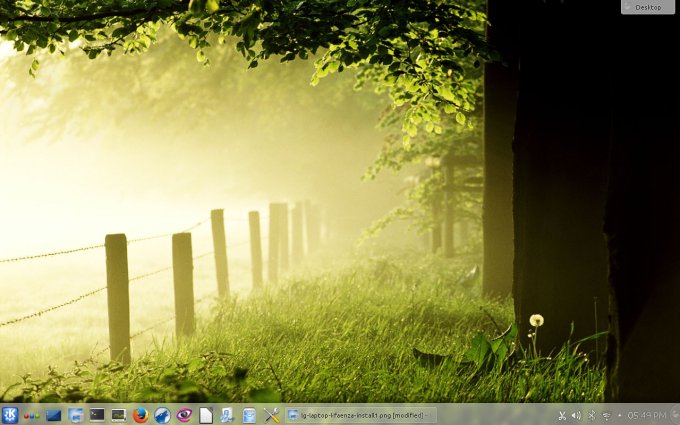Updated: October 9, 2013
A few months back, after I installed Xubuntu on my eeePC netbook, and this effectively gave it a second and much faster life, I also asked you if you have recommendations for my T42 box. Well, today, we are not going to do that. Instead, we will dedicate some time in rejuvenating my LG RD510 box, which I purchased four years back and then installed with four instance of Jaunty.
Since, it has seen a variety of systems being installed, including the rock-solid Lucid, Maverick with the lovely Macbuntu flavor, CentOS, Mint, and even Pangolin more recently. All of these worked great, without any problems whatsoever. The thing is, 4GB of RAM and a still somewhat decent Nvidia 9600M GS card is enough for most tasks. Regardless, I wanted a fresh start. So here we are.

What operating system?
This is an interesting question. Believe it or not, I decided to go for Kubuntu Ringtail. The reason I chose it is because it has shown some really good results recently, and even offered a flawless upgrade on my Pavilion laptop. And since I have upgraded the internal Lucid installation thereon to Linux Mint Maya, it makes sense to do with a bit of variety and try something else here.

As you would expect, all of the hardware was properly detected and initialized. No fiasco like we had with Asus VivoBook recently, unfortunately. Wireless, Nvidia, all in good order, no sweat. But we will get to the nitty details later on.
Housekeeping
Next, I did a bit of data backup before ruining the partition table. It turns out, the laptop and its four operating systems accumulated a fair amount of data, including more than forty native Linux games, going as far back as 2009, with brave candidates from some of the early Humble Bundle deals, a variety of multimedia projects, lots of Web articles and book reviews, tons of screenshots, music, videos, and still more. A total of 35GB of data, in 27,000 directories counting roughly 105,000 files. That took some time.
With the data safely tucked away, I could finally part with the resident players, thanking them for their cooperation, and creating a new reality. This time, I opted to make it simpler and go for a dual-boot configuration.
I decided to partition the 320GB disk in the following manner - An extended partition only, with a 4GB swap as the first, followed by a 200GB /home, and two equal 50GB partitions for the roots. The first one will include Kubuntu 13.04 Raring Ringtail, while the second one will be dedicated to Linux reviews and tests, in addition to the external disk I often use with the HP laptop, and the ever-changing fourth boot option on the T61 machine.

Once this step was done, I installed the distro. Kubuntu did not complain and completed the operation quickly and elegantly in about twenty minutes. After the first boot, everything worked fine. I had to fight the KDEWallet for a few seconds, but nothing drastic.
Kubuntu experience
The distro is extremely light and responsive, which is something I have reported during the 13.04 series reviews. Lots of magical improvements in the kernel space have led to a very lithe, nimble and fast family of systems, across the broad, and even Kubuntu, with its supposedly heavy KDE framework, benefits from the changes. However, the amazing thing is how refreshing Ringtail really is. The magnitude, not the outcome.
It is faster than I expected, and even faster than some of the earlier distros running on the machine. This is quite an improvement, and this is even before displacing the Nouveau driver with the proper Nvidia one. Really nice.

Next, I upgraded the system to the max. No crashes so far, mind. Then, I installed the Nvidia driver, using the Additional drivers tool. No problems, and you really need not fall back to my extensive Nvidia guide, because it seems only to affect the Unity flavor. Anyhow, I tried the version 313, the latest available in the repos.


Once this step was done, I tried some extra pimping and beautification. To my surprise, I learned that the KDE set of the splendid Faenza icons was available, only the download led to a dead link, and thus my enthusiasm choked. I also discovered many other themes and icon links not to be really working, or only partially working, so this kind of sullied the pristine feel of my experience so far.

Other bits and pieces
No crashes still. The laptop is quiet overall. The CPU and memory consumptions are reasonable. The battery life remains unchanged from previous distros, at about 2.5 hours total normal usage time. Then again, with four years of age, this is not such a bad result, either, for a six-cell thingie. Suspend & resume, no worries. Desktop effects, snappy. Everything is quite dandy, again, above and beyond expectations. Printing over network to a Samba resource is still wonky, so I will have to give this more thought and provide an easy solution for the masses.
So far, I am utterly pleased. The only question remaining is, how will the new test distros behave in this setup. I am planning on testing Fedora once again, which did not cooperate well with my T61 box, or Megeia, which simply refuses to boot on most of my systems, so it will be rather interesting. And you will get to read about it.
Conclusion
Well, this is hardly a surprise, if you think about it. A relatively modern processor, plenty of RAM, a good graphics card, it's not exactly rejuvenation in the sense of taking an old Trabant and turning it into a Lambo. Not as such, no. But it still shows that older hardware can run modern Linux distributions just as well, if not better. This is quite encouraging, and surely does not force you to spend money on needless upgrades.
The real test will be what I do with the T42 box. It approaches ten years of age, it only has a 32-bit processor and we will have to deal with the PAE/non-PAE kernel thingie, but since there's a very decent 1.5GB of RAM, I foresee no actual problems. Maybe the graphical stack will get wonky. Anyhow, you still have time to convince me what to test. My current bets include CentOS, Scientific Linux, maybe Xubuntu, or maybe something else entirely. Not sure, but that's where audience participations comes in. See ya.
Cheers.